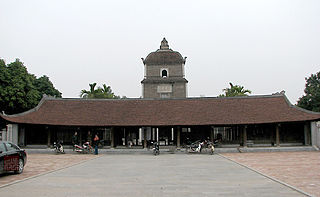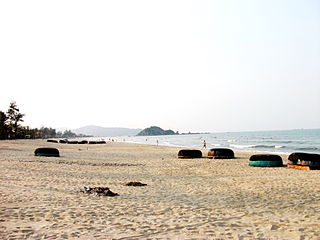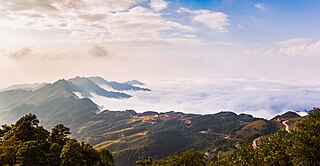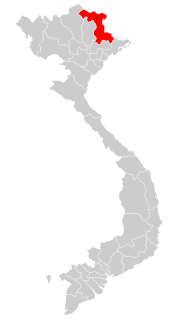Articles related to Vietnam and Vietnamese culture include:

Bắc Ninh is a province of Vietnam, located in the Red River Delta of the northern part of the country. It is the smallest province of Vietnam and is situated to the east of the nation's capital, Hanoi, and borders Bắc Giang province, Hưng Yên province, Hải Dương province and Hanoi. The province covers an area of 822.71 square kilometres and as of 2019 it had a population of 1,368,840. The province's name literally means "northern serenity".

Central Highlands, Western Highlands or Midland Highlands is one of the regions of Vietnam. It contains the provinces of Đắk Lắk, Đắk Nông, Gia Lai, Kon Tum, Lâm Đồng.

Hải Dương is a city in Vietnam. It is the capital of Hải Dương, an industrialized province in the Hanoi Capital Region and the Red River Delta in Northern Vietnam. The city is at the midpoint between the capital Hanoi and major port Haiphong, and is part of the Northern Key Economic Zone. In 2019, Hai Duong city had a population of 507,469.

Nghệ An is a province in the North Central Coast region of Vietnam. It is Vietnam's largest province by area. Nghệ An is located in a central position in North Central Coast. To the east lies the Gulf of Tonkin; to the west the province is bordered by Laos; to the south Hà Tĩnh province; and to the north is Thanh Hóa province. It is located on the east–west economic corridor connecting Myanmar, Thailand, Laos and Vietnam along National Route 7 to the port of Cửa Lò.

Lệ Thủy is a district of Quảng Bình Province in the North Central Coast of Vietnam. The district borders Quảng Ninh District on the north, Vĩnh Linh District on the south, Laos on the west. Lệ Thủy central is 40 km south of the provincial capital Đồng Hới. The district government seat is Kiến Giang Township. The district area is 1420.52 km2, population: 140,804 (1998). Lệ Thủy District is home to Võ Nguyên Giáp and the family of Ngô Đình Diệm. Economy bases on agriculture, mainly rice culture. Mỹ Trạch massacre by French army happened here on 29 November 1947.

Emperor Quang Trung or Nguyễn Huệ, also known as Nguyễn Quang Bình, was the second emperor of the Tây Sơn dynasty, reigning from 1788 until 1792. He was also one of the most successful military commanders in Vietnam's history. Nguyễn Huệ and his brothers, Nguyễn Nhạc and Nguyễn Lữ, together known as the Tây Sơn brothers, were the leaders of the Tây Sơn rebellion. As rebels, they conquered Vietnam, overthrowing the imperial Later Lê dynasty and the two rival feudal houses of the Nguyễn in the south and the Trịnh in the north.

Chi Lăng is a rural district of Lạng Sơn Province in the Northeastern region of Vietnam. It is famous for many decisive battles at Chi Lăng pass in which the Vietnamese defeated the Chinese invaders.
Tan Thanh may refer to several populated places in Vietnam:

Đồng Hỷ is a rural district of Thái Nguyên Province in the Northeast region of Vietnam. As of 2003, the district had a population of 122,932. The district covers an area of 462 km2. The district capital lies at Hóa Thượng.

Gia Bình is a township and capital of Gia Bình District, Bắc Ninh Province, Vietnam.

Lạng Sơn is a province in northern Vietnam, bordering Guangxi province in China. Its capital is also called Lạng Sơn, which is a strategically important town at the border with China and is 137 kilometres (85 mi) northeast of Hanoi connected by rail and road. Lạng Sơn province is bordered by China, Cao Bằng province, Bắc Giang province, Bắc Kạn province, Quảng Ninh province and Thái Nguyên province. The province covers an area of 8310.09 square kilometres and as of 2008 it had a population of 781,655.

Political organizations and Armed forces in Vietnam, since 1912:
Ngô Thị Ngọc Dao posthumous name Quang-thục Trinh-huệ Khiêm-tiết Hòa-xung Nhơn-thánh Dowager Empress (光淑禎惠謙節和沖仁聖皇太后), was a queen consort of Later Lê dynasty and mother of the Vietnamese emperor Lê Thánh Tông.

Cao Lang is a former province of Vietnam.

The government of the Nguyễn dynasty centred around the emperor as the absolute monarch, surrounded by various imperial agencies and ministries which stayed under the emperor's presidency. Following the signing of the Patenôtre Treaty the French took over a lot of control and while the government of the Nguyễn dynasty still nominally ruled the French protectorates of Annam and Tonkin, in reality the French maintained control over these territories and the Nguyễn government became subsidiary to the administration of French Indochina. During World War II the Japanese launched a coup d'état outsting the French and establishing the Empire of Vietnam which was ruled by the Nguyễn government. During the August Revolution the Nguyễn government was abolished in the aftermath of World War II.













